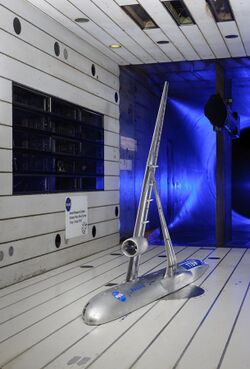Engineering:Boeing X-66
The Boeing X-66 is an experimental airliner under development by Boeing. It is part of the X-plane series, and is being developed in collaboration with NASA and its Sustainable Flight Demonstrator program. It will use an extra-long and thin wing design stabilized by diagonal bracing struts, which is known as a Transonic Truss-Braced Wing. The aircraft configuration is based on research studies referred to as "Subsonic Ultra-Green Aircraft Reach (SUGAR)" which extensively studied truss-bracing and hybrid electric technologies.[1][2]
Development

By early 2019, following extensive wind tunnel testing at NASA Ames Research Center, an optimized truss and more sweep for the 170 ft (52 m) span wing allowed flying higher and faster, up from Mach 0.70–0.75 to Mach 0.80 like current jetliners.[3] Compared to aircraft with cantilevered wings, fuel burn will be reduced by 8-10%, and the technology should be ready by 2030-2035. Aspect ratios up to 27 were evaluated, up from 8-10 for current narrow-bodies.[4] The design was presented at the January 2019 American Institute of Aeronautics and Astronautics (AIAA) conference and the wing folds outboard of the truss to enable its use of airport gates like the 118 ft (36 m)-span 737.[5] (ICAO aerodrome code C)
Later the wing was improved with 20° of sweep and moved forward, the truss section was optimised, tapered with an increased root chord, and optimized with a trailing edge with forward sweep that generates lift. It was tested in early 2019 at the NASA Ames 11 ft (3.4 m) transonic tunnel, then later in 2019 at the 14 by 22 ft (4.3 by 6.7 m) subsonic tunnel at NASA Langley. A full-scale X-plane is being developed and tested under NASA's Ultra-Efficient Subsonic Transport (UEST) plan, outlined in the New Aviation Horizons flight demonstration from 2023. Boeing proposed to modify an MD-80 powered by turbofan engines, but it could test a series/parallel hybrid electric propulsor based on Rolls-Royce LibertyWorks' EVE concept of a geared turbofan. A 1.5 MW (2,000 hp) electric motor/generator mounted between the compressor and the variable pitch fan, fed by batteries to boost the takeoff and climb, allows for a smaller engine and improves efficiency by 4.5% over a 3,500 nmi (4,000 mi; 6,500 km) mission. A tail-mounted BLI fan would ingest and reenergize the slow airflow over the fuselage.[6]
A full-scale demonstrator based on the McDonnell Douglas/Boeing MD-90 was announced on January 18, 2023, with NASA funding $425 million over seven years while Boeing and its partners will invest the remainder of the agreed $725 million,[7] as the airframer had already spent $110 million in sustainable aviation research.[8] Combined with better propulsion and materials, efficiency is targeted at 30% better than current Boeing 737 MAX and Airbus A320neo.[9] Using a shortened MD-90 airframe and CFM International RISE engines, the demonstrator is scheduled to fly in 2028, providing the basis for a possible family of 130-to-210-seat aircraft.[10][11] The full-scale Sustainable Flight Demonstrator (SFD) is designated "X-66A".[1][2]
References
- ↑ 1.0 1.1 O’Shea, Claire (12 June 2023). "Next Generation Experimental Aircraft Becomes NASA's Newest X-Plane". http://www.nasa.gov/press-release/next-generation-experimental-aircraft-becomes-nasa-s-newest-x-plane.
- ↑ 2.0 2.1 Norris, Guy (13 June 2023). "USAF Designates NASA Demo X-Plane X-66A". https://aviationweek.com/defense-space/aircraft-propulsion/usaf-designates-nasa-demo-x-plane-x-66a.
- ↑ "Spreading our wings: Boeing unveils new Transonic Truss-Braced Wing". Boeing. 8 January 2019. https://www.boeing.com/features/2019/01/spreading-our-wings-01-19.page.
- ↑ Hemmerdinger, Jon (9 January 2019). "Boeing unveils trussed wing capable of jet speeds". FlightGlobal. https://www.flightglobal.com/news/articles/picture-boeing-unveils-trussed-wing-capable-of-jet-454898/.
- ↑ Warwick, Graham (8 January 2019). "Boeing Unveils Refined Truss-Braced-Wing Airliner Concept". Aviation Week Network. https://aviationweek.com/commercial-aviation/boeing-unveils-refined-truss-braced-wing-airliner-concept.
- ↑ Norris, Guy; Warwick, Graham (11 January 2019). "Boeing Refines Truss-Braced-Wing Airliner Concept". Aviation Week Network. http://aviationweek.com/future-aerospace/boeing-refines-truss-braced-wing-airliner-concept#comment-1090761.
- ↑ Bardan, Roxana (18 January 2023). "NASA Issues Award for Greener, More Fuel-Efficient Airliner of Future". https://www.nasa.gov/news-release/nasa-issues-award-for-greener-more-fuel-efficient-airliner-of-future/.
- ↑ "Boeing Awarded NASA Sustainable Flight Demonstrator Contract". 18 January 2023. https://investors.boeing.com/investors/news/press-release-details/2023/Boeing-Awarded-NASA-Sustainable-Flight-Demonstrator-Contract/default.aspx.
- ↑ Hemmerdinger, Jon (18 January 2023). "NASA partners with Boeing to develop truss-braced-wing demonstrator". FlightGlobal. https://www.flightglobal.com/airframers/nasa-partners-with-boeing-to-develop-11b-truss-braced-wing-demonstrator/151695.article.
- ↑ Warwick, Graham (18 January 2023). "NASA Picks Boeing's Transonic Truss-Based Wing For Sustainable X-Plane". Aviation Week Network. https://aviationweek.com/air-transport/aircraft-propulsion/nasa-picks-boeings-transonic-truss-based-wing-sustainable-x-plane.
- ↑ Beresnevicius, Rytis (22 June 2023). "CFM's open fan RISE engine to power Boeing X-66A" (in en-US). https://www.aerotime.aero/articles/cfm-rise-boeing-x-66a.
 |


